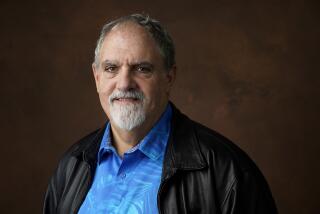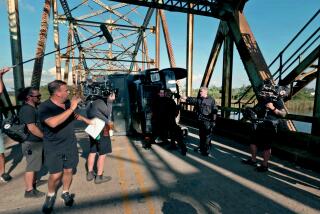Troubled Route to Pirate Epic ‘Cutthroat’ : Movies: As the swashbuckling adventure starring Geena Davis, directed by her husband, Renny Harlin, opens this weekend, financial woes surround its release.
The pirate epic “Cutthroat Island”--the year’s second-most-expensive picture--finally arrives in theaters this weekend, months delayed and millions over budget, with a once-high-flying movie company submerged in its wake.
“Cutthroat” is the work of Finnish-born action director Renny Harlin (“Cliffhanger,” “Die Hard 2”) and stars his wife, Geena Davis. It was produced by Carolco Pictures, responsible for megahits such as “Terminator 2: Judgment Day” and “Basic Instinct,” but which recently declared bankruptcy--a victim of free spending and low-risk financing strategies that cut into profits. Twentieth Century Fox has put in a bid for the Carolco library and most other assets, although this film is being released by MGM.
“Cutthroat” has already been likened by competitors, and even some involved with the production, to this summer’s “Waterworld,” another famously expensive film shot on water that could never turn a profit on its theatrical box office alone.
Harlin, MGM and Carolco insist that “Cutthroat”--billed as a “Treasure Island” for the ‘90s--stands on its own as a non-stop thrill ride, action adventure and should be given a chance to sail before Hollywood naysayers weigh in.
But the roughest seas in this yarn may be in how “Cutthroat” got made at all.
Start with the budget. Some Carolco and MGM sources peg the final figure at $120 million, although Carolco says it’s about $90 million, including interest and insurance fees.
Unlike “Waterworld,” “Cutthroat” does not have a theme park attraction or other tie-ins to bolster revenues. Universal and star Kevin Costner, a producer on “Waterworld,” say that film’s budget was $172 million, but sources involved with the movie have said it climbed higher than $200 million, some putting it at $235 million.
But the gods smiled on Universal, which reportedly got to write off all but $50 million of “Waterworld’s” budget when the studio was sold by Japan’s Matsushita Electric Industrial Corp. to the Canadian distiller Seagram’s.
Another problem for “Cutthroat” is that unlike “Waterworld,” it has no huge star. Davis, who plays a sword-wielding grand dame, has most recently appeared in back-to-back flops (“Speechless” and “Angie”), and co-star Matthew Modine has even less marquee draw.
When the film was first brought to Carolco by producer Laurence Mark, Michael Douglas was expected to star. Mario Kassar, Carolco’s colorful longtime top executive, had pressed Harlin to direct and wanted Davis to play the female lead, a role that was secondary to Douglas’ at the time.
After contemplating the role for weeks and bringing on a second round of writers for rewrites, Douglas--weary from his shoot on “Disclosure” and concerned that he wouldn’t have enough time to prepare for a strenuous role that included intense fencing lessons--dropped out.
At the time, reports said Davis had strong-armed Harlin into beefing up her role and overshadowing Douglas’ character.
“My wife will not talk about this because she doesn’t want to offend anyone in any way and she doesn’t want anything said misinterpreted,” Harlin said last week. “The truth is this: I am friends with Mario. Mario approached me about doing this picture and said he wanted Geena to play the female lead. She said she was scared [about doing] it, that she couldn’t carry this alone. She would only do it if she had a bigger male star. She would do it if Michael said yes. She wanted it to be a ‘Romancing the Stone’ [the 1984 hit that starred Douglas and Kathleen Turner]. She never really wanted to do this picture. She wanted to do ‘Mistress of the Seas.’ ”
That film, Harlin said, “was much less of an adventure and more of an extremely erotic story about these two women and their escapades with pirates. It was more like a ‘Dangerous Liaisons’ on ships.”
But “Mistress,” steered by Jon Peters, fell apart at Columbia Pictures after the director, Paul Verhoeven, failed to agree on a lower budget. Columbia then approached Harlin about directing “Mistress.” At the same time, Kassar was pressing him to do “Cutthroat,” an action picture that he conceded is much more geared to his talents.
The difference was that Columbia was a solid studio with sound financing, while Carolco had been teetering on the brink of bankruptcy for years, relying on foreign investors and its lender, French bank Credit Lyonnais, for the much-needed cash. Harlin had already been through the hurdles of dickering for money with Carolco’s keepers on his last picture, “Cliffhanger,” a film that ended up grossing about $89 million in box office.
“On ‘Cliffhanger,’ the production was postponed three months because we couldn’t get the money,” Harlin said. “I remember I had to tell Sly [Stallone] one day . . . ‘Just get on the plane and go. The money somehow will be there.’ I always felt like we were really flying by the seat of our pants.”
And that, Harlin insisted, is why he demanded a $500,000 “holding fee” for “Cutthroat.” He denied tabloid reports that he sought the money to pay for his lavish wedding and honeymoon.
“It was the first payment on a pay-or-play deal,” the director said--meaning that Harlin was contractually bound to make the movie. The search for a leading man dragged on, and Davis continued to waffle, but Harlin and Kassar pressed her to remain. Eventually, Davis agreed to be in the film. She and Harlin would each be paid salaries of $5.5 million.
Despite Carolco’s dire condition at the time, neither Harlin nor the company--known for its freewheeling spending--changed their ways, production sources say.
“Renny sent this memo to the crew telling them to spare no expense . . . that he wanted this to be the biggest and best pirate movie ever,” said one source formerly with Carolco. “He even had them make the shoelaces for the boots from scratch. Who would ever notice that? All the weapons, just about everything was made from scratch. And the boats . . . they were built and then one of them was blown up.”
Harlin confirmed the memo but said he sent it to inspire the crew--something he is prone to do on most of his movies. “We were not irresponsible. Everyone was worried about whether the money would run out, but I wanted them to believe in the picture, that the company was behind it . . . that this was going to be something special and not just slapped together,” he said.
As for the expense, “when you shoot 100 days in two foreign countries [Malta and Thailand] and you have to build these kind of ships from scratch because they don’t exist, and you have to make the costumes because you go to a costume house in Italy and they give you three pairs of red pants with matching red stripe shirts, well, that’s pretty goofy and hardly believable . . . so you have to start from scratch. You don’t have a choice. I never intended to make some epic, period film where everything has to be perfect for the time. Look at the guns. You didn’t see some of those guns back then. I’m the last person to care about authenticity.
“I wanted to make it only believable enough. But I wanted it to be fun for contemporary audiences,” he said.
Harlin says he cut between $15 million to $20 million in expenses originally anticipated in the budget. He says he even deferred about $3 million of his fee, “which I will probably never see except in my dreams! But that’s OK, because I still love the picture.”
He said the film’s shooting schedule went about 10 days over budget. “The last number I knew the budget to be was about $85 to $90 million or a little less,” he said. “I do not know what the final was with all of the insurance and completion bond costs.” (Completion bonds insure that the picture is finished.)
Still, even $90 million is a significant leap from the original budget of $65 million. One breakdown had $11 million going to Harlin and Davis, about $1 million to Modine, about $3 million covering the cost of the script and numerous rewrites, $3 million for producers’ fees, $3 million to the rest of the cast and the balance for costumes, sets, travel, crew and other production expenses. The additional costs came from shooting delays, special effects and unanticipated expenditures.
Although MGM is distributing the film, which was originally pegged for a summer release, MGM says Carolco is paying for the estimated $15 million to $18 million in marketing costs. (Both companies, ironically, are controlled by Credit Lyonnais.)
“We may not have made this movie, but we believe it is the ultimate popcorn movie that will appeal to audiences from 8 to 80 years old,” said Gerry Rich, MGM’s head of marketing. He acknowledged that it may have a tough launch with so much competition this weekend, particularly with adventure films like Disney’s “Tom and Huck” and Columbia’s “Jumanji.”
“It’s true it is a blood bath out there this weekend,” Rich said. “But we firmly believe ‘Cutthroat’ has a shot. Renny definitely fills the screen and every penny spent is up there.
“He made a fun picture. In the end, ‘Cutthroat’ can’t be the blame for what happened to the company. It was circumstances that sunk Carolco.”
More to Read
Only good movies
Get the Indie Focus newsletter, Mark Olsen's weekly guide to the world of cinema.
You may occasionally receive promotional content from the Los Angeles Times.










